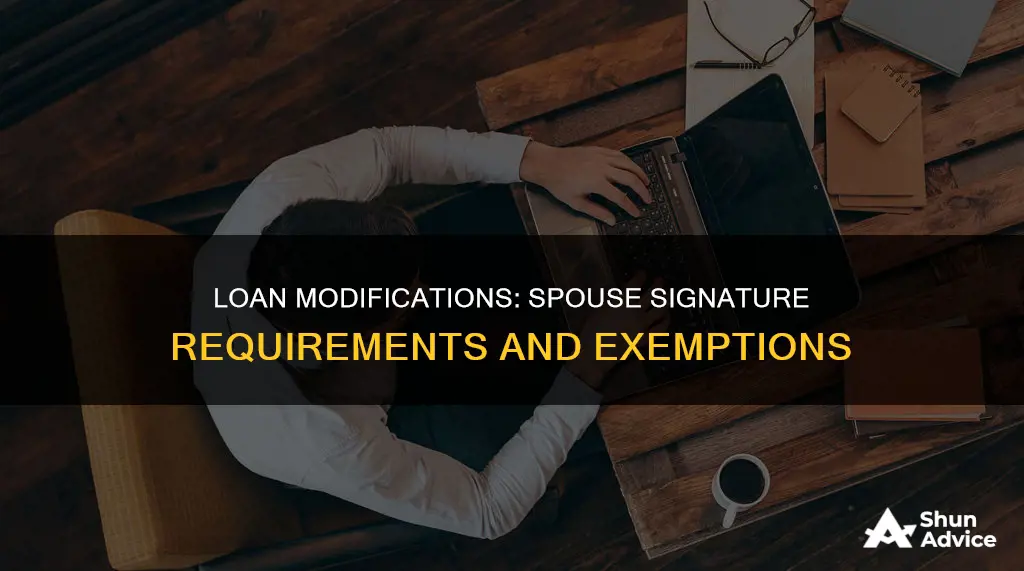
Whether a spouse is required to sign loan modifications depends on several factors, including the type of loan, the terms of the divorce decree, and state law. In most cases, if both spouses signed the original loan documents, then both spouses will also need to sign the modification documents and remain responsible for repaying the loan. However, if the divorce is finalized and one spouse is awarded the home, that spouse can solely apply for a mortgage modification, and the other spouse's signature is typically not required. An exception to this may occur if the divorce decree states that the spouse keeping the home must refinance the loan. In this case, the other spouse would not need to sign the modification documents. It's important to note that the decision to include or exclude a spouse from the loan modification process can impact credit scores and liability for loan repayment.
| Characteristics | Values |
|---|---|
| Spouse's signature required | If the original loan was in one spouse's name only, their spouse is not required to co-sign the modification. If the original loan was in both spouses' names, both must usually sign the modification. |
| Divorce | If one spouse keeps the home post-divorce, they can apply for a modification on their own. |
| Credit risk | Signing a loan modification makes you liable if your spouse falls behind on payments. |
What You'll Learn

If the spouse wants to keep the home
If one spouse wants to keep the home, the first step is to determine who is responsible for the mortgage debt. In many cases, both spouses are legally responsible for repaying the loan and are named on the mortgage loan and the property deed. However, if one spouse keeps the home and the other moves out, the loan contract remains unaffected, and both spouses are still liable for the debt in the eyes of the lender.
If the divorce is not yet finalised, and one spouse wants to keep the home, it is possible to apply for a loan modification. However, if both spouses signed the original loan documents, both will usually have to sign the modification documents and remain responsible for the loan. If one spouse refuses to sign, it can prevent the modification. Signing a loan modification can be risky, especially if you expect your ex-spouse to make the payments, as you will be obligated to repay the modified loan if they don't.
Once the divorce is finalised, the spouse who has been awarded the home can apply for a mortgage modification independently. The other spouse is then released from liability, and their signature is not required. This is subject to the terms in the final divorce decree, which may require the spouse keeping the home to refinance the loan. Divorce is considered a valid financial hardship, and lenders may accept higher debt-to-income ratios in these cases, making it easier to qualify for a modification.
To protect yourself, it is important to understand your options and the potential risks. For example, if you are named on the deed but not the mortgage loan, you may be able to apply for a loan modification but will likely have to assume the loan. Consult a lawyer, and contact your mortgage company to discuss your options, as some may offer streamlined loan modifications. Additionally, consider the financial implications; ensure you have sufficient income to support a modified payment, as too much debt and too little income will hurt your chances of getting the loan modified.
SPCA's Trap Loan Program: Humane Solution for Feral Cats
You may want to see also

The original loan was in both spouses' names
If the original loan was in both spouses' names, both parties are financially responsible for repaying the loan. In the event of a divorce, the spouse who keeps the home can apply for a mortgage modification to remove the other spouse from the loan contract and eliminate their legal responsibility to repay the debt. However, both spouses typically have to sign the modification documents if both spouses signed the original loan documents. The spouse without the house won't be liable for the loan, and it might be easier for them to qualify for a modification after the divorce is final.
It's important to note that removing a spouse from the loan is a separate process that usually involves refinancing, but it may also be achieved through mortgage assumption, bankruptcy, or other legal processes. One option is a loan assumption, where one party takes over full responsibility for the mortgage with the lender's approval, but this is not always available and depends on the original loan terms and lender policies. Another option is a loan modification, where the lender agrees to alter the terms of the existing loan to accommodate the change in borrowers.
If refinancing isn't an option due to financial constraints, credit issues, or lender restrictions, selling the property might be the only solution to remove the obligation from both parties. Removing a name from the deed does not automatically remove them from the mortgage, and the lender may still hold both borrowers responsible for the debt. To remove a spouse from the deed, they will need to sign a quitclaim deed in front of a notary, and the document will need to be notarized and filed with the local county office.
Missing Documents: Nelnet Loans and National Collegiate's Impact
You may want to see also

The spouse is awarded the home post-divorce
The spouse who is awarded the home post-divorce may find themselves spending a greater portion of their income on mortgage payments and other costs associated with owning a home. Before seeking to retain the marital home in a divorce, it is important to carefully plan out your post-divorce budget. This includes considering all the recurring expenses relating to the home, such as mortgage, real estate taxes, utilities, and upkeep costs, as well as major periodic expenses, such as replacing the roof or boiler.
If the spouse keeping the home also intends to keep the mortgage, they will need to apply for a mortgage modification to remove their ex-spouse from the loan contract and eliminate their legal responsibility to repay the debt. This is because, in most cases, the lender will not remove a spouse from the loan documents simply because the couple is no longer married. The best time to apply for a mortgage modification is once the divorce is final, as the spouse without the house will not be liable for the loan. However, it is important to note that the lender may require the spouse keeping the home to refinance the loan instead.
To remove an ex-spouse from the loan contract, the spouse awarded the home will need to contact the lender and provide them with a certified copy of the filed quitclaim deed. The lender may also require the ex-spouse to re-qualify for the mortgage in their name only. This process can vary depending on the state and whether there is a prenuptial agreement in place. In some states, marital property is divided equally between spouses, while in others, it may be divided based on factors such as income and contributions to the marriage.
It is important to note that keeping the marital home during a divorce can be an emotional decision that may dominate attention and distort negotiating positions on other important issues. Spouses should carefully consider their options and seek legal and financial advice before making any decisions.
Understanding the Paycheck Protection Loan Repayment System
You may want to see also

The spouse is unable to make current mortgage payments
If a spouse is unable to make their current mortgage payments, there are a few options to consider. Firstly, it's important to understand the specific financial situation and make necessary adjustments. This may involve cutting back on non-essential spending, using budgeting tools, or even renting out a part of the home to generate additional income.
If financial adjustments are not feasible or insufficient, the spouse may want to consider a loan modification. This involves working with the lender to restructure the mortgage terms, such as reducing the interest rate, extending the loan term, or adding missed payments to the loan balance. To initiate this process, the spouse will need to provide financial documentation and a hardship letter explaining their circumstances. It's worth noting that a loan modification may impact the spouse's credit score, and there is a risk of falling prey to loan modification scams, so caution and thorough research are advised.
In the context of divorce, the options for managing mortgage payments and loan modifications become more complex. If both spouses signed the original loan documents, typically both would need to sign the modification documents as well. However, once the divorce is finalized and one spouse is awarded the home, that spouse can solely apply for a mortgage modification, releasing the other spouse from liability. Divorce is generally accepted as a valid financial hardship, making it easier for the spouse keeping the home to qualify for a modification.
It's important to carefully review the divorce decree, as it may include specific instructions regarding refinancing or removing a spouse's name from the loan. If the spouse who retains the home fails to make payments, the other spouse's credit may be affected, especially if their name remains on the loan. In such cases, consulting an attorney and seeking legal recourse may be necessary.
Seller's Role in FHA Loan Process: What to Know?
You may want to see also

The spouse's name is mentioned in the property deed
If the spouse's name is mentioned in the property deed, they are an owner of the property. In the event of a divorce, the spouse may be entitled to half of the house, even if it is under the other spouse's name. This depends on the financial situation of the couple.
If the spouse is not on the mortgage, they are not responsible for paying it. However, the mortgage lender can foreclose on the house if the mortgage is not paid. If the spouse is on the deed but not on the mortgage, they can still be liable for the debt if the other spouse defaults on the mortgage payments.
If you want to add your spouse to the mortgage, you will generally have to refinance your loan. A simple mortgage modification can also be used to add your spouse to the mortgage. However, if your spouse has a history of financial problems, putting them on the deed may have consequences. Their poor credit score can render you ineligible for refinancing your home.
If you want to remove your spouse from the mortgage, you can refinance the loan in your name only, sell the home, or in some cases, ask your lender to modify the loan or allow you to assume it for a fee. To remove their name from the property deed, the spouse should sign a quitclaim deed in front of a notary. Once this document is notarized, you file it with your local county office.
Sallie Mae Loan App: Hard Inquiry or Not?
You may want to see also
Frequently asked questions
If both spouses signed the original loan documents, then both spouses will usually have to sign the modification documents. However, if the divorce is finalized and one spouse is awarded the home, that spouse can solely apply for a mortgage modification, and the other spouse's signature will not be needed.
If one spouse doesn't agree to sign the loan modification, the deal may fall through. Even if both spouses agree to complete a loan modification and sign the documents, this may not be a good idea if one spouse is moving out of the home and expecting the other to make the payments. This is because, once a loan modification is signed, both spouses are obligated to repay the modified loan.
If your ex-spouse is refusing to pay their share of the loan, you may be able to take them to court. If they are in contempt of a court order, they can be sued. It is also recommended that you talk to the lender and provide them with a copy of the divorce decree, asking them to remove your name from the mortgage.
It is possible to apply for a loan modification while the divorce is pending, but it might be easier for the spouse keeping the home to qualify for a modification after the divorce is final. This is because divorce is considered a "financial hardship", which is one of the eligibility requirements for getting a loan modification.







